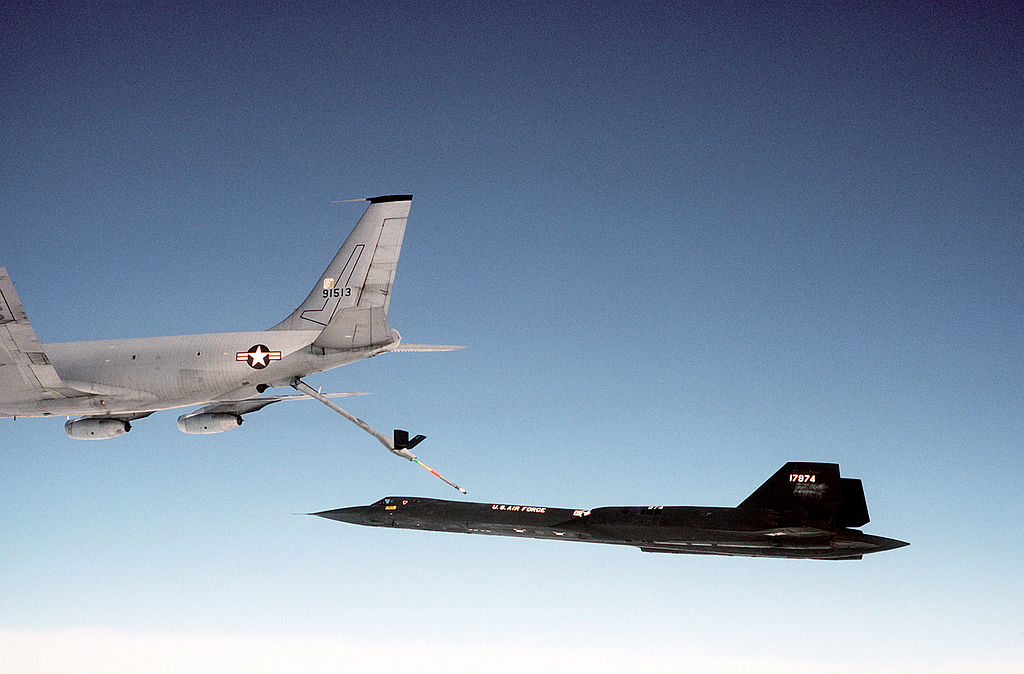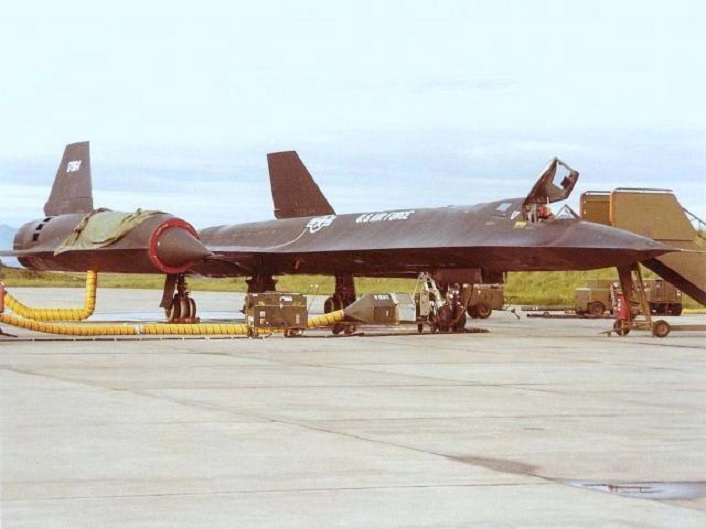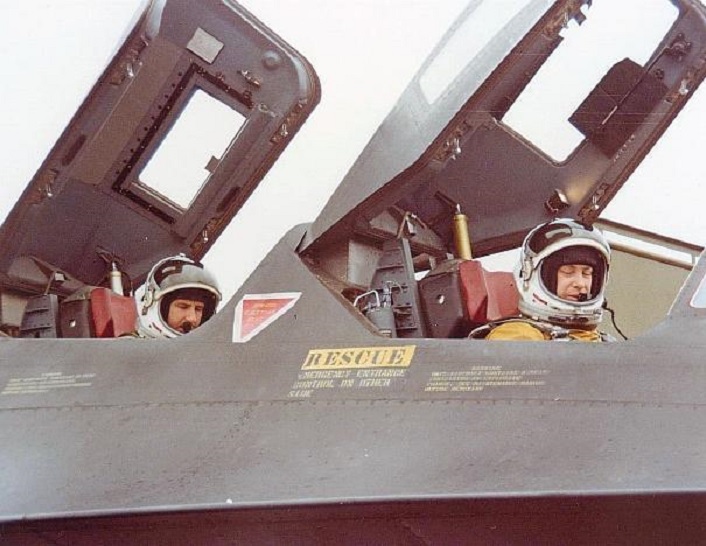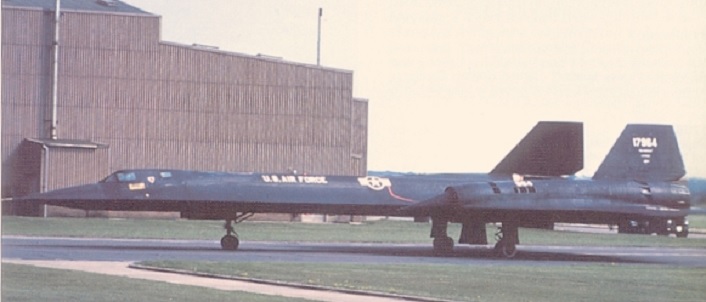“My call sign was ‘Belmont 86’ and my transmissions to approach control were something like this: ‘Bodø Approach, Belmont 86, six-zero miles west, declaring an in-flight emergency, request straight-in approach to land on runway zero seven.’ ‘Belmont 86, say aircraft type, nature of emergency, souls-on-board, and fuel remaining.’ ‘Bodø Approach, Belmont 86, US Air Force Tactical, engine problem, 2 souls, zero plus four-five fuel-on-board.’ ‘Belmont 86, say again aircraft type.’ ‘Bodø Approach, Belmont 86, US Air Force Tactical.’ ‘Belmont 86, I do not understand your aircraft type,’” Bredette (BC) Thomas, SR-71 pilot
In the following post, Lieutenant Colonel Bredette (BC) Thomas tells the story of the infamous SR-71 Emergency Landing in Norway. The Blackbird was crewed by BC Thomas himself and Lieutenant Colonel Jay Reid (Reconnaissance Systems Officer or RSO).
This story originally appeared on Tyler Rogoway’s website Foxtrotalpha.Jalopnik.com and then in John Altson’s book The Black Line.
That Time an SR-71 Made an Emergency Landing in Norway
On August 13, 1981, Jay Reid and I made the first SR-71 landing in Continental Europe. It was virtually unannounced – and not particularly welcomed.
The Mission
Before establishing a continuous SR-71 presence in Europe in 1982 (at RAF Mildenhall, England), the 9th Strategic Reconnaissance Wing, the responsible headquarters for all SR-71 operational flights, was sometimes tasked to fly a particularly important higher-headquarters mission from Beale AFB in California to the Soviet Union and back.
The purpose was to photograph (with either film or radar) and collect electronic data in and around the Soviet Naval facility at Murmansk, located on the Kola Peninsula in the Barents Sea above the Arctic Circle, in the extreme northwest portion of the Soviet Union, north of Norway and east of Finland.
We required information about their air-defense electronic warfare capabilities and specifically, their antiaircraft surface-to-air (SAM) missile systems. Murmansk was a strategic nuclear submarine base and maintenance facility, and since knowing the disposition of all nuclear threats was vital for the security of the United States, Murmansk was one of our most significant reconnaissance objectives.
My Reconnaissance Systems Officer (RSO), Jay Reid, and I were assigned this mission scheduled for Wednesday, August 12, 1981, in SR-71 aircraft #964.
We reported for the flight at 7:00 p.m., checked the weather and last-minute changes to the mission requirements, updated the intelligence briefing, met with the mobile crew and SR-71 crew chief, ate a meal of steak and eggs, donned our space suits, conducted an aircraft preflight, and were ready for a 9:47 p.m. takeoff.
The flight profile called for a 45,000-pound takeoff fuel load; a rendezvous with two tankers over Idaho to fill our tanks; acceleration to Mach 3+ (2,000 mph) while cruise-climbing to 80,000 feet; descending to 26,000 feet to meet more tankers over Goose Bay, Labrador; crossing the Atlantic Ocean just south of Greenland and Iceland at Mach 3 to a third refueling over the North Sea, northeast of Scotland.
The next acceleration was to Mach 3.25 to penetrate the Soviet air defense region around Murmansk. Passing west of Norway, then north of Finland, we headed toward the Soviet coast by flying inbound from a point in the Barents Sea and approaching the landmass at Murmansk directly at 90 degrees head-on.
There is no doubt that our presence was heralded to Soviet personnel on the ground by the sweet (and rather loud) sound of freedom: the distinctive double-sonic boom of the 2,200-mile-per-hour SR-71.
That knowledge would always give us a certain inward sense of pride; not in ourselves altogether, but pride in the aircraft, the engineers and designers who built her, the maintenance people who made her safe to fly, and the faithful tanker crews who were always there when we needed fuel. All of these support personnel were vital for any successful mission.
The Soviet Union claimed their sovereign territory extended 100 nautical miles from their landmass. The international norm is 12 miles. Heading inbound, we turned so that we flew within 12.5 miles of the Soviet coast in a 30-degree right-banked turn while obtaining radar imagery (or photographs) and recording Soviet electronic countermeasures.
This somewhat provocative technique was trolling: we stimulated the Soviet defenses, causing their radios and radar to bristle with electronic information, thus impelling them to reveal telltale electromagnetic signatures indicating the type of equipment, modes of operation, and limits. There were sometimes other American assets offshore, but within radio range, which also collected electronic transmissions.
After departing the “take area,” the plan was to refuel again over the North Sea, accelerate to Mach 3, refuel for a fifth time over Goose Bay, then fly Mach 3 thereafter to Beale AFB. We planned to land at 8:15 am on August 13 after 10.5 hours of very intense flying.
We were operating a long distance from home base, the mission was deemed vital, and no crew member ever wanted to abort a flight. Any mission deviation could lead easily to an international incident, would be scrutinized by the highest National Command Authority, and possibly result in our names appearing in every major newspaper in the world.
We certainly felt this responsibility but had the utmost faith in our preparation, training, and the talent and dedication of all our support branches.
The Emergency
After transiting Murmansk and while hooked up with the tankers during the fourth refueling, I saw a flicker of the Master Warning light.
Jay Reid announced the light at the same time that I saw it in my peripheral vision. I disconnected from the tanker’s boom and maneuvered back to the pre-contact position. Our indication was the illumination of the left-engine oil supply low-quantity red warning light. From our training and experience with the aircraft emergency checklists, we knew immediately that this required that we “land as soon as possible.”
The mandate to land immediately was borne out of the long experience with malfunctions: the type that would crash the airplane if another single system failed.
The natural tendency for military aircrews is to complete the mission if humanly possible. To counter this inclination, the Wing Commander had designated certain emergencies sufficiently critical to require immediate landing. This was one of those emergencies.
Our mission planning and alternate airfield study had prepared us to know quickly where to fly if an emergency required immediate landing. Some military intelligence might limit our choice of a suitable landing field, depending on the political situation, and of course, the weather was always a major consideration.
Jay and I quickly agreed that recovery at the joint civilian/military airbase at Bodø (pronounced: “Buddha”), located on the Norwegian coast a few miles above the Arctic Circle, was best. We were about 60 miles away.
The Arrival
We wasted no time notifying the tanker crews of our decision to land. They set up a holding pattern in international airspace to assist in refueling, or to be our radio-relay if necessary. Their standing orders were to await our call to release them, presumably after our safe landing.
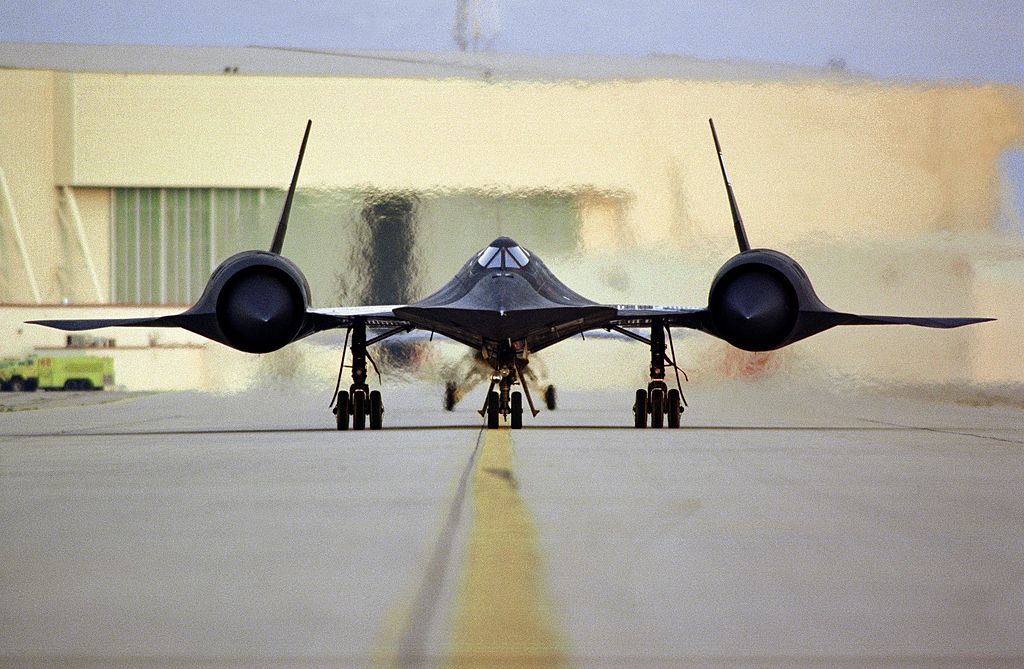
While Jay was transmitting our mandatory abort reports via high-frequency, long-range radio, I contacted Norwegian Approach Control. Our orders were not to broadcast that we were flying an SR-71, but rather give the general type as “U.S. Air Force Tactical,” which really meant nothing to a controller concerned about arranging for emergency equipment and notifying proper authorities of our emergency condition.
My call sign was “Belmont 86” and my transmissions to approach control were something like this:
“Bodø Approach, Belmont 86, six-zero miles west, declaring an in-flight emergency, request straight-in approach to land on runway zero seven.”
“Belmont 86, say aircraft type, nature of the emergency, souls-on-board, and fuel remaining.”
“Bodø Approach, Belmont 86, US Air Force Tactical, an engine problem, 2 souls, zero plus four-five fuel-on-board.”
“Belmont 86, say again aircraft type.”
“Bodø Approach, Belmont 86, US Air Force Tactical.”
“Belmont 86, I do not understand your aircraft type.”
“This is Belmont 86, we will land in approximately 10 minutes and I will deploy 3 drag parachutes: 2 small and one 40-foot chute. I will jettison all three on the runway. I don’t have time now to talk.”
We were cleared to land with nothing more said. We touched down at Bodø on August 13 at 1:12 p.m. Norwegian time after a total flight of 6.4 hours.
When we were on a short-final approach, tower controllers had no problem identifying our aircraft type, and immediately sent out notifications which, we learned later, included the local press.
What could we expect? What kind of reception would the Norwegians give us and would the airplane be secure, especially considering that we had on-board highly classified images and electronic recordings from Murmansk?
The Reception
I asked for and was given taxi directions to the Norwegian military ramp where I could see some friendly-looking F-104s, the front-line NATO fighter aircraft. After I shut down the engines and we opened our canopies, the first person to greet us was a Norwegian military pilot who said: “Welcome, do you know Bill Groninger?”
Bill Groninger was a fellow SR-71 pilot who was a USAF instructor pilot before he was chosen for the SR-71 program. The Norwegian pilot was his student. We learned that many Norwegian fighter pilots received their initial training in the USA. We definitely were among friends!
We were quickly introduced to General Olav Aamoth, the Wing Commander at Bodø. He asked for any special requirements and I requested full-time guards be placed on the aircraft with only myself and Jay Reid authorized to admit personnel to the plane. He agreed and assured us that the aircraft would be guarded continuously. I then asked for a secure phone to call the Command Post at Beale AFB.
General Aamoth drove us to an underground labyrinth of tunnels carved into the side of a mountain, containing maintenance shops and aircraft. He directed me to a telephone within his Command Center.
I called the 9SRW Commander, and told him the time of the abort and that operations were normal up to the emergency, thus relaying that we had the reconnaissance data on board. This information was needed to arrange for the proper retrieval of the mission materials.
We briefly discussed the nature of the emergency, and I assured him that the aircraft was safe. He said that we were to stay there until the aircraft was repaired, which would probably take three days. The 9SRW had already started a recall for the support personnel necessary for the recovery of the SR-71.
General Aamoth seemed unusually concerned, as he insisted that a Norwegian officer physically be present with us until we left. He introduced us to an F-104 pilot, 1 Lt Roar Strand, who would help us with anything we might require. He was a very pleasant guy, and I kind of felt sorry for him because I was sure he had better things to do than to “mind” us for 3-4 days.
Roar Strand was very accommodating. After all the immediate activities associated with bedding down the aircraft were accomplished, he took Jay and me to his apartment, where we met his beautiful girlfriend, then to a restaurant in downtown Bodø where we spent a pleasant evening.
Roar accompanied us to the transient quarters to sleep in the same room with Jay and me. Early the next morning, he went with us to a military dining hall for breakfast. It was there that I got my first real surprise of the trip: the only food presented was about four types of fish soup, all of which, to this unaccustomed American, smelled terrible, especially so early in the morning. I asked if any cold cereal was available and thankfully, there was. Corn flakes. Espresso coffee completed the fare.
General Aamoth joined us and with him was the American Air attache to Norway who had just flown in from Oslo specifically to see us. I knew then that this visit was attracting more attention than any of us needed or wanted. He asked about the emergency, the condition of the airplane, and wanted to know if anything unusual or unpleasant had happened to us.
I assured him that we were fine and that recoveries such as this one were well planned, and the maintenance team would probably be here that day or the next. We did not anticipate any logistical problems as this type of activity was performed often, usually without help from other local organizations, and the Norwegians were taking extra care to assure that we were not contacted or hindered.
Recovery Operations
The rest of the day was devoted to making preparations for the maintenance recovery team from Beale AFB. General Aamoth, to my surprise, stated specifically that he did not want any talk or outward expression of anything clandestine (not that we would anyway.)
More than once, he made the explicit statement that when we landed, he considered us to be a NATO-allied aircraft in distress and that military courtesy and professional consideration meant that we were to be afforded the support necessary to see us on our way and that he did not want any mention of reconnaissance activity or publicity.
It was way too late for the admonition concerning publicity, however.
Virtually every newspaper in Norway had news of a “Spy Plane” landing at Bodø splashed across its front page. Newspapers in the USA also had the story. The reports generally said that it was the highest-flying and fastest airplane in the world, and opined on what type of “spying” we were doing.
Jay and I did not like the publicity but were relieved that no newspapers published our pictures or names. None of us flying reconnaissance missions wanted to be publicly identified while we were engaged in these activities.
Our missions were highly classified, and no good could ever come from talking to reporters about anything associated with our reconnaissance flights.
The next day, August 15, a KC-135Q from Beale AFB arrived carrying our special fuel for the SR-71; the deployment commander, Lt Col Randy Hertzog, who was also the Commander of the 1st Strategic Reconnaissance Squadron (1SRS); and the maintenance crew plus civilian technical representatives from Lockheed.
The recovery plan written by the 9SRW stated that in foreign stations, the recovery team would all wear civilian clothes so as not to disclose who was military. This did not sit well with General Aamoth! He told me to tell Col. Hertzog to have all military personnel wear military uniforms.
I did not know why he would issue such an order, but I complied. The military team dutifully returned to the KC-135 and changed into uniforms.
Over the next two days, the maintenance team ran into several problems repairing the aircraft. We had parts flown in from various sources. A spare “engine start cart,” a machine containing 2 Buick Wildcat engines in tandem and specifically designed to mechanically rotate the SR-71 engines for starting, was flown in by C-130. On the third day, our aircraft was repaired and made ready for takeoff.
Since preparing the SR-71 for a supersonic (Mach 3) flight would have taken more equipment and time, we elected to fly the subsonic directly to RAF Mildenhall, England, from which the SR-71 had conducted operations previously. We would fly in formation with the KC-135Q, which had landed at Bodø for our support 2 days earlier.
Departure
The maintenance crew performed outstandingly and we were ready to depart on Sunday, August 16. Preflight preparations for Jay and me were smooth, except our first engine-start attempt failed. The start cart could not, observing normal rpm and torque limits, achieve the required aircraft engine speed for a safe start.
On the second attempt, the crew chief, Clarence “Skip” Hosler, valiantly ignored the cart rpm/torque limits and informed me on inter-phone that this would be the last attempt. He later told me that the connecting rod glowed red-hot just before the aircraft engine reached the start rpm.
We took off at 1:42 p.m. It was the roughest takeoff I ever made in an SR-71. The runway was smooth to sight, but owing to the very long, slender, and flexible fore-body of the SR-71 (where the nose wheel is located) and the distance from the nose wheels to the main landing gear (42 feet), the slight undulating wavelike runway set up a vertical motion in the cockpit which amplified as we accelerated for takeoff.
It was getting so bad by the time we achieved rotation speed (180 knots) that I was very concerned that something might break before liftoff (210 knots). The acceleration of the SR-71 was quick and I was able to raise the nose before the up-and-down oscillation became traumatic. With the gear up, everything returned to normal. We rendezvoused with our tanker for a planned refueling to augment our takeoff fuel, and landed at 2:53 p.m. local time in England, for a flight of 2.2 hours.
With a million members of the Polish Solidarity movement having gone on strike on 7 August, and mounting tension between Communist state officials and the rest of the Polish population, Strategic Air Command (SAC) directed that upon arrival, we would set up a deployment base at RAF Mildenhall and conduct several additional operational missions before returning home.
Jerry Glasser and Mac Hornbaker were sent from Beale AFB to meet us when we arrived from Norway and they flew an operational mission a few days later. We were ordered to stay at RAF Mildenhall until relieved, so Jay and I also flew another operational mission after Jerry and Mac. When Rich Young and Ed Bethart arrived as our replacements, we departed for Beale AFB on September 2.
What started out for us as a 10.5-hour, round-robin mission, California to the Soviet Union and back, turned into a 21-day marathon of SR-71 missions, involving 6 SR-71 aircrew members, a host of maintenance and support personnel, and a true adventure for us all.
Along the way, we made some very special friends.
Afterward
After I retired from the US Air Force and our SR-71 reconnaissance activities were no longer classified, I contacted General Aamoth. He also retired from the military after being Chief of Staff for the Norwegian Air Force from 1985 through 1991.
I asked him about his reluctance to have our military personnel wear civilian clothes and why he admonished us not to do or say anything that would identify our mission as being reconnaissance. He told me a very interesting story.
On May 1, 1960, General Aamoth was a fighter pilot (then a Lieutenant) in the Norwegian Air Force stationed at Bodø. That was the day that Francis Gary Powers was shot down flying a CIA U-2 aircraft over the Soviet Union. Although Powers had taken off from Pakistan, his intended landing base was Bodø, the same Norwegian base where I landed.
Furthermore, the then-commander of Bodø knew about the U-2 and that it was to land at his home base; however, neither the Norwegian Prime Minister nor the Chief of the Norwegian Air Force knew anything about it. To make matters much worse, the Soviet Premier, Nikita Khrushchev, threatened to “nuke Bodø” for “cooperating” with the United States in the “U-2 Affair.” After an investigation, the Military Commander was summarily fired.
General Aamoth saw a very stark parallel to that story when we landed. He told me that he was sitting in his office when we were on the final approach. The airfield tower controller telephoned and told him to look out his window to see what aircraft was landing at his field asking to be parked on his military airport apron.
I now understand General Aamoth’s concern!
As of 2016, Roar Strand is still an active pilot, flying worldwide for Scandinavian Airlines (SAS). He has homes in Norway and France and is married to Maryann, the girlfriend I met at his apartment in 1981. They are the proud parents of 3 and are also grandparents.
As for SR-71 aircraft #964, a veritable workhorse for the SR-71 program, it is displayed at the Strategic Air and Space Museum (formerly the SAC Museum) near Omaha, Nebraska.
John Morgan (RSO) and I had an SR-71 emergency on April 5, 1984, in aircraft #974, and landed again at Bodø. General Aamoth was there to meet me a second time. He was then a Major General and Commander of Tactical Air Forces North. I told him that I really didn’t mean to do it a second time! There was minimum publicity and we departed within 2 days. By then, we were operating out of RAF Mildenhall and the logistical support was much closer and quicker than in 1981.
The SR-71 (#974) in which I landed at Bodø the second time was the first SR-71 to fly combat missions in the Vietnam War. It was also the last Blackbird to crash. While flying at Mach 3 over the Philippine Sea on April 21, 1989, her left engine seized causing shrapnel to explode into critical hydraulic lines and subsequently rendering the flight controls completely inoperative. The crew, Dan House (pilot), and Blair Bozek (RSO) ejected safely and were recovered by Filipino fishermen.
By May 10, 1989, US Navy and Air Force personnel had recovered the wreckage from 200 feet below the ocean surface and returned her to Okinawa for disposal.
The Black Line is available to order here.
Photo by U.S. Air Force, www.wvi.com/~sr71webmaster/bodo.html and Eric Simonsen via www.wvi.com/~sr71webmaster/bodo.html



